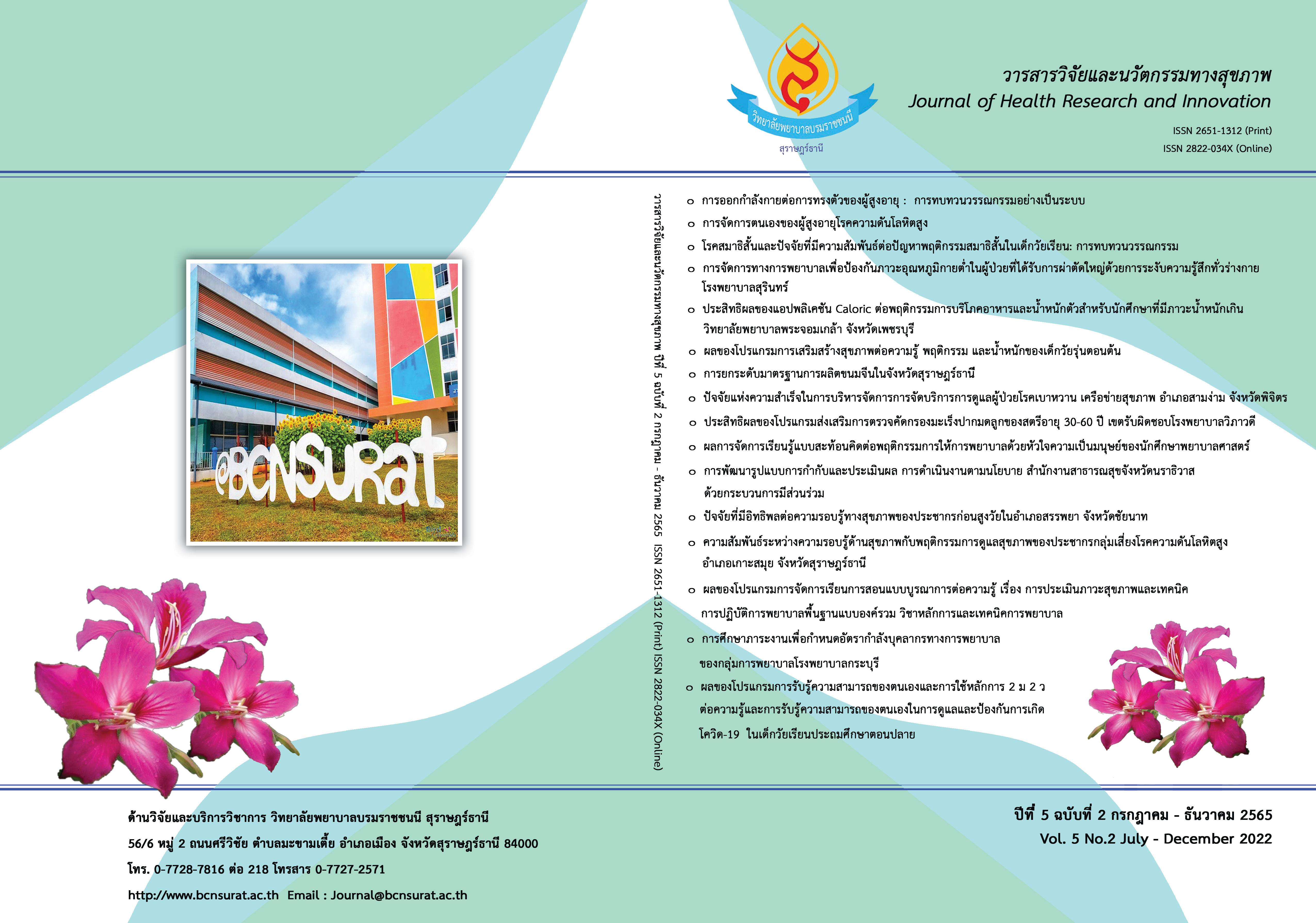โรคสมาธิสั้นและปัจจัยที่มีความสัมพันธ์ต่อปัญหาพฤติกรรมสมาธิสั้นในเด็กวัยเรียน: การทบทวนวรรณกรรม
คำสำคัญ:
ปัญหาพฤติกรรมสมาธิสั้น, เด็กวัยเรียน, โรคสมาธิสั้นบทคัดย่อ
โรคสมาธิสั้นเป็นกลุ่มอาการที่มีความผิดปกติของพัฒนาการ ซึ่งเกิดได้จากพันธุกรรม และอาจจะเกิดจากความบกพร่องของการทำงานที่สมอง ส่งผลให้มีปัญหาเกี่ยวกับการควบคุมตนเอง เช่น อาการซน อยู่ไม่นิ่ง ขาดการยั้งคิดหรือหุนหันพลันแล่น และขาดสมาธิที่ต่อเนื่อง ซึ่งเป็นพฤติกรรมที่มากกว่าพฤติกรรมที่เกิดขึ้นกับเด็กวัยเดียวกัน ส่งผลให้การทำหน้าที่ในการดำเนินชีวิตประจำวันหรือการเข้าสังคมบกพร่องไป เด็กสมาธิสั้น มี 2 ลักษณะ คือ 1) สมาธิสั้นแท้ เกิดจาก 2 สาเหตุหลัก ได้แก่ การผิดปกติจากสมองตั้งแต่กำเนิด และภาวะที่มีต่อสมองตั้งแต่อยู่ในครรภ์มารดา เช่น มารดาขาดสารอาหาร หรือได้รับสารพิษ การคลอดมีปัญหา เด็กเป็นลมชัก หรือสมองอักเสบ ส่งผลให้สารสื่อประสาทที่คุมสมาธิมีปริมาณน้อยกว่าเด็กปกติ เด็กจะมีอาการและเห็นอาการได้ชัดมากขึ้นหากเด็กได้รับการดูแลที่ไม่เหมาะสมหรือมีสิ่งต่างๆ มากระตุ้นมากเกินไป และเกิดจากการถ่ายทอดทางพันธุกรรม และ 2) สมาธิสั้นเทียม เกิดจากการเลี้ยงดู สิ่งแวดล้อม แต่เด็กสมองปกติดี อาการคล้ายสมาธิสั้น มักพบในเด็กอนุบาลที่ถูกเร่งเรียนมากเกินไป
บทความวิชาการฉบับนี้มีวัตถุประสงค์ เพื่อทบทวนวรรณกรรมโรคสมาธิสั้นเกี่ยวกับปัจจัยที่มีความสัมพันธ์ต่อปัญหาพฤติกรรมสมาธิสั้นในเด็กวัยเรียน สาเหตุการเกิดโรคสมาธิสั้น ปัจจัยที่เกี่ยวข้องกับปัญหาพฤติกรรมของเด็กวัยเรียนโรคสมาธิสั้น ปัญหาพฤติกรรมของเด็กโรคสมาธิสั้น ผลกระทบของโรคสมาธิสั้นที่เกิดขึ้นในเด็กวัยเรียน และบทบาทพยาบาลในการดูแลเด็กโรคสมาธิสั้นวัยเรียน ปัญหาพฤติกรรมของโรคสมาธิสั้นที่ปรากฏขึ้นในช่วงชีวิตวัยเด็กจะส่งผลกระทบต่อพัฒนาการด้านบุคลิกภาพ ทางการเรียนและทางสังคมได้ ซึ่งยังไม่มีวิธีการรักษาที่ทำให้โรคนี้หายขาด แต่การได้รับการดูแลที่ถูกต้อง จะช่วยให้เด็กโรคสมาธิสั้นสามารถเรียนรู้ได้เต็มตามศักยภาพอย่างเหมาะสมตามวัย ประสบความสำเร็จในการเรียนและการใช้ชีวิต สามารถอยู่ในสังคมได้อย่างมีความสุข
เอกสารอ้างอิง
Boon-yasidhi, V. (2012). Attention Deficit Hyperactivity Disorder: Diagnosis and Management. Journal of the Psychiatric Association of Thailand, 57(4), 373 – 386.
Chalotorn, P. (2021). Prevalence and Associated Factors of Depression Among The Primary Caregivers of Patients with ADHDat Chaophrayayommarat Hospital in Thailand. Medical Journal, 40(3), 429 – 438.
Chaturongkakool, C. (2022). Short attention span is closer to the child than I thought. Retrieved October 10, 2022, from https://www.bangkokhospital.com/content/adhd-disorder
Child and Adolescent Mental Health Rajanagarindra Institute. (2019). Attention Deficit Hyperactivity Disorders. Retrieved October 8, 2022, from https://new.camri.go.th/Service/Chumai, T. (2016). Early Childhood Growth and Development. Hua Hin Sook Jai Khai Kangwon Journal. 1(2). 18 – 33.
Cloud Hospital. (2021). Pediatric Neurology. Retrieved December 1, 2022, from https://icloudhospital.com/th/departments/
Department of Mental Health. (2018). Attention Deficit Hyperactivity Disorders. Retrieved October 8, 2022, from THAIDMH/posts/754737428029809
Ekathikhomkit, N. (2017). Child Temperament and Parental Stress. The Journal of Psychiatric Nursing and Mental Health. 31(3). 17 – 29.
Faculty of Medicine Siriraj Hospital. (2022). Attention Deficit Hyperactivity Disorders. Retrieved October 8, 2022, from https://dmh.go.th/news/view.asp?id=2481
Hongsanguansri, S. (2012). Attention-Deficit/Hyperactivity Disorder. In Lortrakool, M. & Sukanich, P. psychiatry Ramathibodi (3rd ed.). (495 – 505). Bangkok: RamaHospital. (in Thai)
Johnston, C. (1996). Parent characteristics and parent-child interactions in families of nonproblem children and ADHD children with higher and lower levels of oppositional-defiant behavior. Journal Abnormal Child Psychology, 24(1), 85 – 104.
Juengsiragulwit, D., Pityaratstian, N., & Nimnuan, C. (2012). The Efficacy of Brief Group Cognitive Behavioral Therapy in Children with ADHD. Journal of the Psychiatric Association of Thailand, 57(1). 19 - 28.
Keawkungwal, S. (2013). special child psychology. In Weerakitkosol, J. ADHD and Hyperactivity (3rd ed.). (376 – 394). Bangkok: Pimdee.
Lakanapichitkul, D. (1997). Attention Deficit/Hyperactivity Disorder: ADHD. Sukhothai Thammathirat Open University Journal, 10(1), 94 – 101.
Lotrakul, P. (2001). Student Mental Health Handbook. Bangkok: Wongkamon. (in Thai)
Manarom Hospital. (2021). ADHD. Retrieved December 1, 2022, from https://www.manarom.com/blog/adhd_disorder.html
Maskasame, K. (2020). Attention Deficit/Hyperactivity Disorder in Children and Adolescence. Journal of Charoenkrung Pracharak Hospital, 16(2), 75 – 102.
Nakmit, T. (2016). The Influence of Selected Factors on Mothers’ Perception of Behavioral Problems in School-age Children with Attention Deficit Hyperactivity Disorder. Retrieved from Master of Nursing Science (pediatric), Prince of Songkla University.
Ngamkum, D. & Yunibhan, J. (2013). Relationships Berween Family Factors And Behavioral Problems In Children With Attention-Deficit Hyperactivity Disorder, Eastern Region. The Journal of Psychiatric Nursing and Mental Health, 27(1), 16 – 28.
Patjanasoontorn, N., Singkhom-ard, J., Unphrai, P., Srisawat, W., Udomsin, C., & Kittisiriwattanakul, O. (2011). Learning and Behavioral Problems in a Demonstration School Children, Education level 1 (Grade 1 – 3) in Khon Kaen Province. Journal of the Psychiatric Association of Thailand, 56(4). 345 – 351.
Pityaratstian, N., Booranasuksakul, T., Juengsiragulwit, D. & Benyakorn, S. (2014). ADHD Screening Properties of the thai Version of Swanson, Nolan, and Pelham IV Scale (SNAP-IV) and Strengths and Difficulties Questionnaire (SDQ). Journal of the Psychiatric Association of Thailand, 59(2). 97 - 110.
Piyasil, W. & Ketmarn, P. (2002). ADHD. In Piyasil, W. & Ketmarn, P. Textbook of Child and Adolescent Psychiatry. (209 – 219). Bangkok: Beyond Enterprise. (in Thai)
Pongwilairat, K., Louthrenoo, O., Charnsil, C. & Witoonchart, C. (2005). Quality of Life of Children with Attention-Deficit/Hyper Activity Disorter. Journal of the Medical Association of Thailand. 88(8). 1062 – 1066.
Rajanagarindra Institute of Child Development. (2017). A guide to screening and adjusting behavior for children with ADHD for Parents: Rajanagarindra Institute of Child Development, Siampimnana: Chiangmai. (in Thai)
Rajanagarindra Institute of Child Development. (2017). Knowledge of ADHD and and the role of teachers in caring for children with ADHD, Siampimnana: Chiangmai. (in Thai)Sangridech, M. & Wacharasindhu, A. (2019). Stress, coping behaviors and related-factors in mothers of child with ADHD at Outpatient Department of Child and Adolescent Psychiatric Clinic, King Chulalongkorn Memorial Hospital. Chula Med Bull, 1(5), 451 – 461.
Sinrachatanant, A. & Tankam, T. (2017). Guidelines for the care of child and adolescent psychiatric disorders. (69 – 79). Bangkok: The Agricultural Co-operative Federation of thailand. (in Thai)
Sirirutraykha, T. (2022). Attention Deficit Hyperactivity Disorders. Retrieved October 8, 2022, from https://www.happyhomeclinic.com/sp03-adhd.htm
Srimakutphun, N. (2007). The Correlation between Self-Esteem and Parenting Styles of Children with Attention-Deficit/Hyperactivity Disorder Attending Child Psychiatric Outpatient Unit of King Chulalongkorn Memorial Hospital. Retrieved from Department of Psychiatry, Faculty of Medicine, Chulalongkorn University Description.
Srisamurt, A. (2021). Nurse’ roles in Attention Deficit Hyperactivity Disorder (ADHD). Mahasarakham Hospital Journal. 18(2). 140 – 147.
Soikum, K. (2013). Behavioral problems in school-aged children with ADHD. Retrieved from Faculty of Public Health, Chiang Mai University is University.
Thavorncharoensap, M. (2019). ADHD: drug treatment. Retrieved December 2, 2022, from https://pharmacy.mahidol.ac.th/th/knowledge/article/479
Trangkasombat, U. (2003). Meditate for your child. Bangkok: Sunta.
Winatpatthama, C., (2021). Mental health problems of children, adolescents and school age Retrieved October 10, 2022, from
ดาวน์โหลด
เผยแพร่แล้ว
รูปแบบการอ้างอิง
ฉบับ
ประเภทบทความ
สัญญาอนุญาต
ลิขสิทธิ์ (c) 2022 วิทยาลัยพยาบาลบรมราชชนนี สุราษฎร์ธานี

อนุญาตภายใต้เงื่อนไข Creative Commons Attribution-NonCommercial-NoDerivatives 4.0 International License.
บทความที่ได้รับการตีพิมพ์เป็นลิขสิทธิ์ของวารสารวิทยาลัยพยาบาลบรมราชชนนี สุราษฎร์ธานี
ข้อความที่ปรากฏในบทความแต่ละเรื่องในวารสารวิชาการนี้เป็นความคิดเห็นส่วนตัวของผู้เขียนแต่ละท่านไม่เกี่ยวข้องกับวิทยาลัยพยาบาลบรมราชชนนี สุราษฎร์ธานี และคณาจารย์ท่านอื่นๆในวิทยาลัยฯ แต่อย่างใด ความรับผิดชอบองค์ประกอบทั้งหมดของบทความแต่ละเรื่องเป็นของผู้เขียนแต่ละท่าน หากมีความผิดพลาดใดๆ ผู้เขียนแต่ละท่านจะรับผิดชอบบทความของตนเองแต่ผู้เดียว



